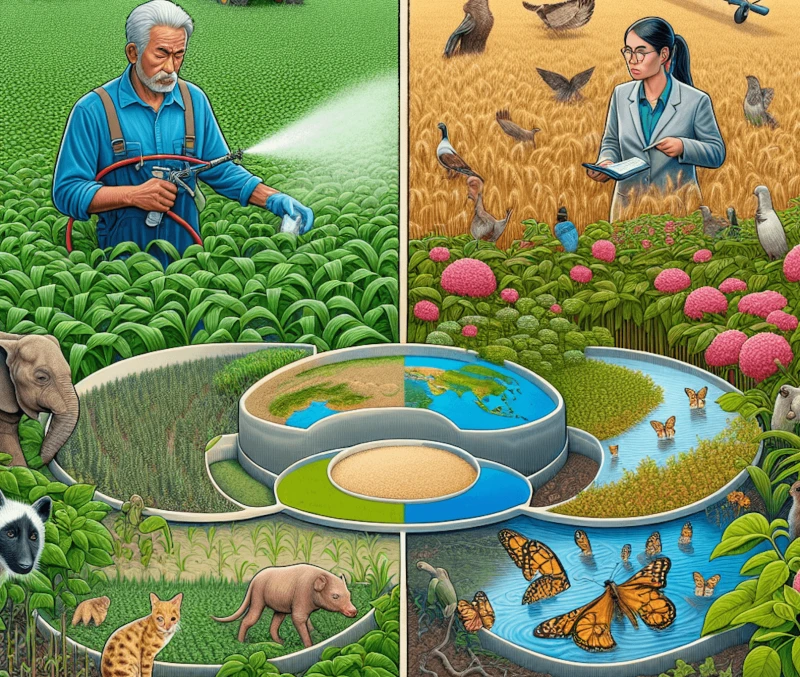University study: Cataloguing the negative impact of agricututral pesticides on insects and animals—and what should be done
University study: Cataloguing the negative impact of agricututral pesticides on insects and animals—and what should be done


Pesticides affect a diverse range of non-target species and may be linked to global biodiversity loss. The magnitude of this hazard remains only partially understood. We present a synthesis of pesticide (insecticide, herbicide and fungicide) impacts on multiple non-target organisms across trophic levels based on 20,212 effect sizes from 1,705 studies. For non-target plants, animals (invertebrate and vertebrates) and microorganisms (bacteria and fungi), we show negative responses of the growth, reproduction, behaviour and other physiological biomarkers within terrestrial and aquatic systems.
Pesticides formulated for specific taxa negatively affected non-target groups, e.g. insecticidal neonicotinoids affecting amphibians. Negative effects were more pronounced in temperate than tropical regions but were consistent between aquatic and terrestrial environments, even after correcting for field-realistic terrestrial and environmentally relevant exposure scenarios. Our results question the sustainability of current pesticide use and support the need for enhanced risk assessments to reduce risks to biodiversity and ecosystems.
Pesticides are used globally to support agricultural production and protect human and animal health in both domestic and commercial situations1,2,3,4,5,6,7,8. At sufficient environmental concentrations, insecticide, fungicide and herbicide exposure can affect non-target organisms by disrupting their survival, growth, reproduction and behaviour (e.g. detection of stimuli), as well as effects on other metabolic and physiological processes (e.g. biomarkers of neural function or immunity, cellular respiration, photosynthesis)9. Some of the negative impacts of pesticides are known.
For example, fungicides may decrease the biomass of arbuscular mycorrhizal fungi, affecting their symbioses with higher plants10; herbicides may reduce plant pollen viability11 and carbohydrate metabolism12; insecticides (targeting pest herbivores) may cause long-term declines in non-target insect pollinators associated with mass-flowering crops13. Such impacts appear widespread across taxa, with individual studies reporting effects on microorganisms14, plants15, invertebrates5,16,17, amphibians18, birds6,19 and mammals20.
…
Our analysis of field-realistic application rates confirmed the strong evidence for overall (insecticides, fungicides and herbicides together) significant negative effects on animal reproduction ….
…
Overall, our synthesis comprehensively shows that insecticides, fungicides and herbicides have broad-scale detrimental effects on all groups of non-target organisms tested. Pesticides consistently decreased growth and reproduction across all taxonomic groups, while also eliciting behavioural responses in animals and perturbing multiple endpoints linked to metabolic or physiological status. Given the ubiquitous use of pesticides worldwide, estimated at about 4.1 million tons of active ingredient applied in 201539, these findings emphasize the potential for prevalent non-target impacts relating to widespread pesticide use. Specifically, these results suggest that pesticide use has the potential to result in wider perturbation of ecological communities and functions.
While we identified responses for individual compounds, it is likely that these effects may be exacerbated through additive or potentially synergistic effects where compounds are applied in combination or to areas with existing residues present4. We acknowledge that the reduction of pesticide use, while a superficially simple solution, is, in practice, likely to have widespread and significant consequences for food production and farmer livelihoods. Nevertheless, our findings highlight the need for widespread policy drivers to adopt solutions to reduce pesticide use and/or maximize the efficiency of inputs.
This is an excerpt. Read the original post here

 | Videos | More... |

Video: Nuclear energy will destroy us? Global warming is an existential threat? Chemicals are massacring bees? Donate to the Green Industrial Complex!
 | Bees & Pollinators | More... |

GLP podcast: Science journalism is a mess. Here’s how to fix it

Mosquito massacre: Can we safely tackle malaria with a CRISPR gene drive?

Are we facing an ‘Insect Apocalypse’ caused by ‘intensive, industrial’ farming and agricultural chemicals? The media say yes; Science says ‘no’
 | Infographics | More... |

Infographic: Global regulatory and health research agencies on whether glyphosate causes cancer
 | GMO FAQs | More... |

Why is there controversy over GMO foods but not GMO drugs?

How are GMOs labeled around the world?

How does genetic engineering differ from conventional breeding?
 | GLP Profiles | More... |

Alex Jones: Right-wing conspiracy theorist stokes fear of GMOs, pesticides to sell ‘health supplements’




 From plastic coasters to human hearts: Inside the race to print the human body
From plastic coasters to human hearts: Inside the race to print the human body A single high dose of LSD can ease anxiety and depression for months
A single high dose of LSD can ease anxiety and depression for months CRISPR pork: U.S. approves first gene-edited pigs for consumption
CRISPR pork: U.S. approves first gene-edited pigs for consumption ‘SuperAgers’: Why some people have the brains and memory capacity of people decades younger
‘SuperAgers’: Why some people have the brains and memory capacity of people decades younger  Baby food panic, brought to you by trial lawyers hoping to prosecute by press release
Baby food panic, brought to you by trial lawyers hoping to prosecute by press release From ‘Frankenfood’ to superfood: Can the purple tomato overcome GMO myths to win over consumers?
From ‘Frankenfood’ to superfood: Can the purple tomato overcome GMO myths to win over consumers? Viewpoint: Life and death decisions: RFK, Jr.’s shady FDA “expert panels” operate in secret with no transcripts or conflict of interest reviews
Viewpoint: Life and death decisions: RFK, Jr.’s shady FDA “expert panels” operate in secret with no transcripts or conflict of interest reviews When farmers deny science: The hypocrisy hurting agriculture’s credibility
When farmers deny science: The hypocrisy hurting agriculture’s credibility
